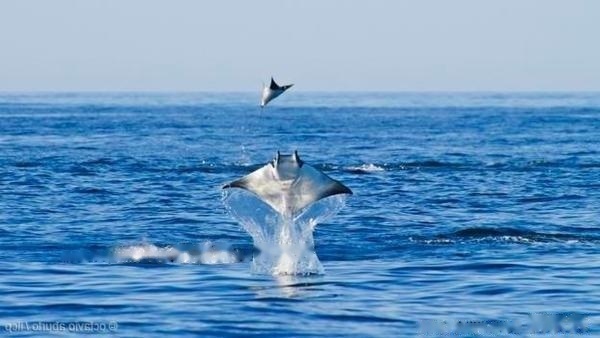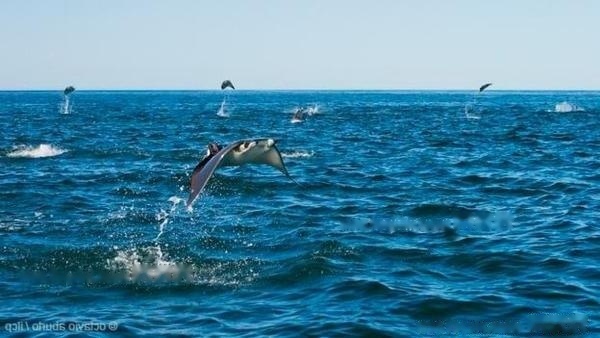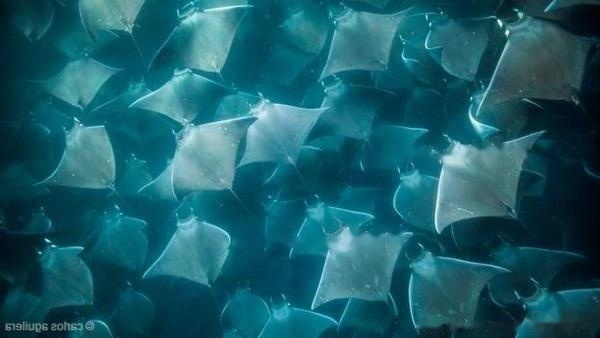Beijing time on May 22, according to foreign media reports, manta rays often gather in groups, and from time to time they make spectacular flying performances on the sea, which is amazing. However, scientists haven't figured out exactly why they do this.

Manta rays can leap more than 2 meters above the surface and glide for seconds
Manta rays and sharks Fish is a cartilaginous fish. They have a broad, flat body with pectoral fins like wings. Whether in the water or in the air, the flying movements of manta rays are equally beautiful, and they are also called flying rays. Manta rays can jump more than 2 meters above the surface of the sea and can keep gliding for several seconds. However, they fall into the water in an unattractive posture. They often land on the surface of the water with a loud noise.
In Mexico's Gulf of California, scientists filmed the behavior of manta rays. They found that hundreds of manta rays form large groups and their prancing performances can last up to 24 hours.
Joshua Stewart of the Scripps Institution of Oceanography said: When you're sitting on a ship in these huge clusters, it's like sitting In the pot of corn, the corn kept popping into the air. Everywhere you could see the manta rays jumping out of the water and then crashing down with a loud thud, sometimes just metres from you. Stewart continued. Conduct research on rays in Mexico and other waters of the world.

Scientists have proposed many explanations for why manta rays leap out of the water, including foraging, mating, communication, and parasite removal
Manta rays shoot straight up and out of the water at top speed, often falling straight down with their flat bellies. However, they sometimes seem to lose control, bouncing and twisting before touching the surface. Tuwart said.
Manta rays are mysterious and lively in the face of divers, making it difficult for scientists to observe them in the wild. Manta swarms like those in the Gulf of California are actually hard to spot because they can appear in different locations and at different times from year to year, Stewart said.
In order to get enough water out of the water, the manta ray needs to start accelerating at a considerable depth. All manta ray species are known to prancing, as do their ray relatives, Stewart said. There are many theories trying to explain this behavior, including foraging, mating, communication and parasite removal.

Hundreds of manta rays congregate off the coast of Mexico each year, and their populations are severely threatened under pressure from commercial fishing
While prancing behavior may occur during foraging or mating, we believe that the most likely purpose of prancing out of water is communication. There are many ways of communicating in different behavioral scenarios. However, Manta and ray prancing may serve multiple purposes, Stewart said.
Analyzing the video data, Stewart determined that both male and female manta rays prancing. His team also identified a possible brooding site for the manta ray, where juveniles forage along inshore near areas where flocking and prancing behaviors typically occur. There is evidence that female manta rays mate immediately after giving birth, Stewart said. It's just speculation, but it's possible that female manta rays could give birth in a nursery area and then mate in the same area.
Scientists have observed manta rays prancing ahead of a feast. We think they jumped to tell other companions that there was food, and used the jump as a signal to gather, Stewart said.

Scientists observe jumping behavior in both male and female Manta rays
Along with these clues, we think that the jumping of Monkey manta rays may be to identify clusters with nearby congeners Theoretically, this behavior would increase population density and overall number of individuals, thereby providing more mating options and increasing the probability of each individual getting a mating.
When manta rays reach sexual maturity Later, their devotion to their offspring is closer to that of mammals than to other fish. After a prolonged pregnancy, female manta rays tend to produce only one offspring. This makes them particularly vulnerable to the pressure of commercial fishing.
As a very flocking species, manta rays are easy targets for fishermen. A single trawling can often deal a severe blow to manta ray populations. Because of this, manta ray gatherings in the Gulf of California are actually very vulnerable to anthropogenic pressure, with the biggest threat coming from bycatch in suspended gillnet fisheries, Stewart said. move, and a few large-scale fishing can take a huge hit to their populations.”
Stewwart is currently working on researching the reasons for the aggregation of manta rays in the Gulf of California and counting the number of manta rays. Population numbers, and future work will focus on seasonal changes in manta ray locations and habitats. (Nintendo)
![[Dog Training 5] The training method of pet dog dining etiquette](/static/img/12192/12192_1.jpg)







